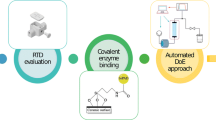Abstract
The scope of the present study aims at demonstrating the application of 3-D printing technology for catalytic applications. A novel microreactor containing immobilized palladium nanocatalyst (Pd/Co3O4) was designed and fabricated in-house for the efficient upgrade of liquid phase morin oxidation from batch to flow procedure. Reaction conditions such as time, reaction temperature, catalyst amount and hydrogen peroxide (H2O2) concentration were investigated to fully benchmark the catalytic efficiency in both systems. The conversion and the kinetic data obtained in both systems reveal that the reaction proceeds faster in the flow reactor compared to batch under similar reaction conditions. In addition to enhanced catalytic activity, the stability of both systems was evaluated exemplarily by recycling and reusing recovered catalyst. The microreactor demonstrates an extended service life based on the recyclability studies conducted. Based on these results, the simple, low-cost 3-D printed reactionwares described in this study appears as a promising approach for the oxidation of morin dye in continuous flow.

Graphical abstract











Similar content being viewed by others
Reference
Liu X, Ünal B, Jensen KF (2012) Heterogeneous catalysis with continuous flow microreactors. Catal Sci Technol 2:2134
Pu X, Su Y (2018) Heterogeneous catalysis in microreactors with nanofluids for fine chemicals syntheses: Benzylation of toluene with benzyl chloride over silica-immobilized FeCl3 catalyst. Chem Eng Sci 184:200–208
Sharma M, Reddy V, Kulkarni SAA (2014) 3D flow reactors: flow, hydrodynamics, and performance. Ind Eng Chem Res 53:1916–1923
Ley SV (2016) Catalysis Science & Technology Editorial – Flow Chemistry and Catalysis. Catal Sci Technol 6:4676–4677
Mostrou S, Sipőcz T, Nagl A, Fődi B, Darvas F, Föttinger K, Van Bokhoven JA (2018) Catalytic oxidation of aqueous bioethanol: an efficient upgrade from batch to flow. React Chem Eng 3:781–789
Rossetti I (2016) Flow chemistry: new concepts from batch to continuous organic chemistry
Tanimu A, Jaenicke S, Alhooshani K (2017) Heterogeneous catalysis in continuous flow microreactors: A review of methods and applications. Chem Eng J 327:792–821
Kumar V, Paraschivoiu M, Nigam KDP (2011) Single-phase fluid flow and mixing in microchannels. Chem Eng Sci 66:1329–1373
Pommella A, Tomaiuolo G, Chartoire A, Caserta S, Toscano G, Nolan SP, Guido S (2013) Palladium-N-heterocyclic carbene (NHC) catalyzed C–N bond formation in a continuous flow microreactor. Effect of process parameters and comparison with batch operation. Chem Eng J 223:578–583
Zhang J, Gong C, Zeng X, Xie J (2016) Continuous flow chemistry: New strategies for preparative inorganic chemistry. Coord Chem Rev 324:39–53
Hessel V, Kralisch D, Kockmann N (2014) Novel process windows: innovative gates to intensified and sustainable chemical processes,. Wiley, Hoboken
Razzaq T, Glasnov TN, Kappe CO (2009) Continuous-flow microreactor chemistry under high-temperature/pressure conditions. European J. Org. Chem 2009:1321–1325
Latocha J, Wojasiński M, Jurczak K, Gierlotka S, Sobieszuk P, Ciach T (2018) Precipitation of hydroxyapatite nanoparticles in 3D-printed reactors. Chem Eng Process Intensif 133:221–233
Watts P, Haswell SJ (2005) The application of micro reactors for organic synthesis. Chem Soc Rev 34:235–246
Watts K, Baker A, Wirth T (2014) Electrochemical synthesis in microreactors. J Flow Chem 4:2–11
Kundu S, Bhangale AS, Wallace WE, Flynn KM, Guttman CM, Gross RA, Beers KL (2011) Continuous flow enzyme-catalyzed polymerization in a microreactor. J Am Chem Soc 133:6006–6011
Descorme C, Gallezot P, Geantet C, George C (2012) Heterogeneous catalysis: a key tool toward sustainability. ChemCatChem 4:1897–1906
Frost CG, Mutton L (2010) Heterogeneous catalytic synthesis using microreactor technology. Green Chem 12:1687–1703
Piscopo CG (2015) Supported sulfonic acids: Solid catalysts for batch and continuous-flow synthetic processes. ChemistryOpen 4:383–388
Yao X, Zhang Y, Du L, Liu J, Yao J (2015) Review of the applications of microreactors. Renew Sustain Energy Rev 47:519–539
Silva GCO, Correa JR, Rodrigues MO, Alvim HGO, Guido BC, Gatto CC, Wanderley KA, Fioramonte M, Gozzo FC, de Souza ROMA (2015) The Biginelli reaction under batch and continuous flow conditions: catalysis, mechanism and antitumoral activity. RSC Adv 5:48506–48515
Akwi FM, Watts P (2018) Continuous flow chemistry: where are we now? Recent applications, challenges and limitations. Chem Commun 54:13894–13928
Morgan AJL, San Jose LH, Jamieson WD, Wymant JM, Song B, Stephens P, Barrow DA, Castell OK (2016) Simple and versatile 3D printed microfluidics using fused filament fabrication. PLoS One 11:e0152023
Bhattacharjee N, Urrios A, Kang S, Folch A (2016) The upcoming 3D-printing revolution in microfluidics. Lab Chip 16:1720–1742
Hashmi S (2014) Comprehensive materials processing, Newnes
Chen C, Mehl BT, Munshi AS, Townsend AD, Spence DM (2016) R.S. Martin, 3D-printed microfluidic devices: fabrication, advantages and limitations—a mini review. Anal Methods 8:6005–6012
Kitson PJ, Symes MD, Dragone V, Cronin L (2013) Combining 3D printing and liquid handling to produce user-friendly reactionware for chemical synthesis and purification. Chem Sci 4:3099–3103
Dilberoglu UM, Gharehpapagh B, Yaman U, Dolen M (2017) The role of additive manufacturing in the era of industry 4.0. Procedia Manuf 11:545–554
Bressan LP, Robles-Najar J, Adamo CB, Quero RF, Costa BMC, de Jesus DP, da Silva JAF (2019) 3D-printed microfluidic device for the synthesis of silver and gold nanoparticles. Microchem J.
Serra AC, Docal C, d’A AM, Gonsalves R (2005) Efficient azo dye degradation by hydrogen peroxide oxidation with metalloporphyrins as catalysts. J Mol Catal A Chem 238:192–198
Das M, Bhattacharyya KG (2014) Oxidation of Rhodamine B in aqueous medium in ambient conditions with raw and acid-activated MnO2, NiO, ZnO as catalysts. J Mol Catal A Chem 391:121–129
Wieprecht T, Heinz U, Xia J, Schlingloff G, Dannacher J (2004) Terpyridine-manganese complexes: A new class of bleach catalysts for detergent applications. J Surfactants Deterg 7:59–66
Ilunga AK, Meijboom R (2016) Synthesis of narrowly dispersed silver and gold nanoparticles and their catalytic evaluation for morin oxidation. Appl Catal A Gen 509:17–29
Ncube P, Hlabathe T, Meijboom R (2015) The preparation of well-defined dendrimer-encapsulated palladium and platinum nanoparticles and their catalytic evaluation in the oxidation of morin. Appl Surf Sci 357:1141–1149
Xaba MS, Meijboom R (2017) Kinetic and catalytic analysis of mesoporous Co3O4 on the oxidation of morin. Appl Surf Sci 423:53–62
(2012) Match! 2 software for Phase Identification from Powder, 2nd ed., Impact Crystal
Lv Y, Xin Z, Meng X, Tao M, Bian Z (2018) Ni based catalyst supported on KIT-6 silica for CO methanation: Confinement effect of three dimensional channel on NiO and Ni particles. Microporous Mesoporous Mater 262:89–97
Wu Z, Deng J, Liu Y, Xie S, Jiang Y, Zhao X, Yang J, Arandiyan H, Guo G, Dai H (2015) Three-dimensionally ordered mesoporous Co3O4-supported Au–Pd alloy nanoparticles: High-performance catalysts for methane combustion. J Catal 332:13–24
Thommes M (2010) Physical adsorption characterization of nanoporous materials. Chemie Ing Tech 82:1059–1073
Taghizadeh M, Akhoundzadeh H, Rezayan A, Sadeghian M (2018) Excellent catalytic performance of 3D-mesoporous KIT-6 supported Cu and Ce nanoparticles in methanol steam reforming. Int J Hydrogen Energy 43:10926–10937
Poyraz AS, Kuo C-H, Biswas S, King’ondu CK, Suib SL (2013) A general approach to crystalline and monomodal pore size mesoporous materials. Nat Commun 4:2952
Mogudi BM, Ncube P, Meijboom R (2016) Catalytic activity of mesoporous cobalt oxides with controlled porosity and crystallite sizes: evaluation using the reduction of 4-nitrophenol. Appl Catal B Environ 198:74–82
Yue J (2018) Multiphase fl ow processing in microreactors combined with heterogeneous catalysis for e ffi cient and sustainable chemical synthesis. Catal Today 308:3–19
Zhao D, Ding K (2013) Recent advances in asymmetric catalysis in flow. ACS Catal 3(5):928–944
Polzer F, Wunder S, Lu Y, Ballauff M (2012) Oxidation of an organic dye catalyzed by MnOx nanoparticles. J Catal 289:80–87
Ndolomingo MJ, Meijboom R (2016) Kinetics of the catalytic oxidation of morin on γ-Al2O3 supported gold nanoparticles and determination of gold nanoparticles surface area and sizes by quantitative ligand adsorption. Appl Catal B Environ 199:142–154
Nemanashi M, Meijboom R (2015) Catalytic behavior of different sizes of dendrimer-encapsulated Au(n) nanoparticles in the oxidative degradation of morin with H2O2. Langmuir 31:9041–9053
Topalovic T (2007) Catalytic bleaching of cotton: molecular and macroscopic aspects
Zhang X, Wiles C, Painter SL, Haswell SJ (2006) Microreactors as tools for chemical research. Chim Oggi 24:43–45
Benke JN-S (2014) Micro-reactors: A new concept for chemical synthesis and technological feasibility. Mater Sci Eng 39:89–101
Gutierrez L, Gomez L, Irusta S, Arruebo M, Santamaria J (2011) Comparative study of the synthesis of silica nanoparticles in micromixer–microreactor and batch reactor systems. Chem Eng J 171:674–683
Subbaramaiah V, Srivastava VC, Mall ID (2013) Catalytic wet peroxidation of pyridine bearing wastewater by cerium supported SBA-15. J Hazard Mater 248:355–363
Mohammadi Z, Entezari MH (2018) Sono-synthesis approach in uniform loading of ultrafine Ag nanoparticles on reduced graphene oxide nanosheets: An efficient catalyst for the reduction of 4-Nitrophenol. Ultrason Sonochem 44:1–13
Ndolomingo MJ, Meijboom R, Applied Catalysis B (2016) Environmental Kinetics of the catalytic oxidation of morin on Al2O3 supported gold nanoparticles and determination of gold nanoparticles surface area and sizes by quantitative ligand adsorption. Appl Catal B Environ 199:142–154
Huang K, Xu Y, Wang L, Wu D (2015) Heterogeneous catalytic wet peroxide oxidation of simulated phenol wastewater by copper metal–organic frameworks. RSC Adv 5:32795–32803
Fathima NN, Aravindhan R, Rao JR, Nair BU (2008) Dye house wastewater treatment through advanced oxidation process using Cu-exchanged Y zeolite: A heterogeneous catalytic approach. Chemosphere 70:1146–1151
Inchaurrondo N, Cechini J, Font J, Haure P (2012) Strategies for enhanced CWPO of phenol solutions. Appl Catal B Environ 111:641–648
Unnikrishnan P, Srinivas D (2016) Heterogeneous catalysis in industrial catalytic processes for fine and specialty chemicals. Elsevier Inc, Amsterdam, pp 41–111
Lousada CM, Yang M, Nilsson K, Jonsson M (2013) Catalytic decomposition of hydrogen peroxide on transition metal and lanthanide oxides. J Mol Catal A Chem 379:178–184
kinetic studio (2010) www.tgkscientific.com: TgK Scientific Limited, n.d
Keznu EN (2015) Practical Solid Modeling For 3D Printing With OpenSCAD
Prusa J (2016) 3D Printing handbook.User manual for 3D printers:Original Prusa i3 MK2 kit 1.75 mm. https://www.prusa3d.com/downloads/manual/prusa3d_manual_175_en.pdf
Bingwa N, Meijboom R (2014) Kinetic evaluation of dendrimer-encapsulated palladium nanoparticles in the 4-nitrophenol reduction reaction. J Phys Chem C 118:19849–19858
Lebed PJ, de Souza K, Bilodeau F, Lariviere D, Kleitz F (2011) Phosphonate-functionalized large pore 3-D cubic mesoporous (KIT-6) hybrid as highly efficient actinide extracting agent. Chem Commun 47:11525–11527
An K, Alayoglu S, Musselwhite N, Plamthottam S, Melaet G, Lindeman AE, Somorjai GA (2013) Enhanced CO oxidation rates at the interface of mesoporous oxides and Pt nanoparticles. J Am Chem Soc 135:16689–16696
Hibben M, Holmes S. tinkering with tinkercad A Beginner ’ s Guide to Creating 3D Printer Designs With Presenters: Tinkering With Tinkercad , 2nd ed
Alimi OA, Bingwa N, Meijboom R (2019) Homemade 3-D printed flow reactors for heterogeneous catalysis. Chem Eng Res Des 150:116–129
Morgan AJL, San Jose LH, Jamieson WD, Wymant JM, Song B, Stephens P, Barrow DA, Castell OK (2016) Simple and versatile 3D printed microfluidics using fused filament fabrication. PLoS One 11:1–17
Bolcos PO (2015) Evaluation of mixing efficiency in a microfluidic cartridge using a finite element method
Wirth T (2013) Microreactors in organic chemistry and catalysis. Wiley, Hoboken
Zotova N, Hellgardt K, Kelsall GH, Jessiman AS, Hii KKM (2010) Catalysis in flow: the practical and selective aerobic oxidation of alcohols to aldehydes and ketones. Green Chem 12:2157–2163
Acknowledgements
The authors thank the National Research Foundation of South Africa for the financial support, {{Grant specific unique reference number (UID) 111710}}. The University of Johannesburg is gratefully acknowledged for funding and the use of TEM in the spectrau laboratory. We also appreciate Mr D. Harris and Dr R. Meyer from Shimadzu South Africa (Pty) Ltd for their analytical instruments.
Author information
Authors and Affiliations
Corresponding author
Additional information
Highlights
• 3D printed flow reactor was designed, fabricated and characterized.
• Palladium nanoparticles supported mesoporous cobalt oxide (Pd/Co3O4) catalyst was prepared and characterized.
• The activity of the catalyst was investigated in batch and continuous flow system and the results are directly compared.
Electronic supplementary material
ESM 1
(DOCX 3322 kb)
Rights and permissions
About this article
Cite this article
Alimi, O.A., Akinnawo, C.A., Onisuru, O.R. et al. 3-D printed microreactor for continuous flow oxidation of a flavonoid. J Flow Chem 10, 517–531 (2020). https://doi.org/10.1007/s41981-020-00089-3
Received:
Revised:
Accepted:
Published:
Issue Date:
DOI: https://doi.org/10.1007/s41981-020-00089-3




